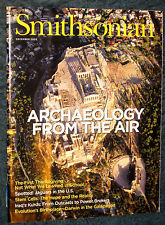 Smithsonian Magazine: “Native Intelligence” by Charles C. Mann
Smithsonian Magazine: “Native Intelligence” by Charles C. Mann

Published in the December 2005 issue.
This is a very exhaustive article on early Wampanoag and Pilgrim relations, the culture and politics of the region, and the background of the “first Thanksgiving.” Very highly recommended reading.
The following is an excerpt from the first page of the article:
Native Intelligence
The Indians who first feasted with the English colonists were far more sophisticated than you were taught in school. But that wasn't enough to save them...
On March 22, 1621, a Native American delegation walked through what is now southern New England to meet with a group of foreigners who had taken over a recently deserted Indian settlement. At the head of the party was an uneasy triumvirate: Massasoit, the sachem (political-military leader) of the Wampanoag confederation, a loose coalition of several dozen villages that controlled most of southeastern Massachusetts; Samoset, sachem of an allied group to the north; and Tisquantum, a distrusted captive, whom Massasoit had brought along only reluctantly as an interpreter.
Massasoit was an adroit politician, but the dilemma he faced would have tested Machiavelli. About five years before, most of his subjects had fallen before a terrible calamity. Whole villages had been depopulated. It was all Massasoit could do to hold together the remnants of his people. Adding to his problems, the disaster had not touched the Wampanoag’s longtime enemies, the Narragansett alliance to the west. Soon, Massasoit feared, they would take advantage of the Wampanoag’s weakness and overrun them. And the only solution he could see was fraught with perils of its own, because it involved the foreigners—people from across the sea.
Europeans had been visiting New England for at least a century. Shorter than the Natives, oddly dressed and often unbearably dirty, the pallid foreigners had peculiar blue eyes that peeped out of bristly, animal-like hair that encased their faces. They were irritatingly garrulous, prone to fits of chicanery and often surprisingly incompetent at what seemed to Indians like basic tasks. But they also made useful and beautiful goods—copper kettles, glittering colored glass and steel knives and hatchets—unlike anything else in New England. Moreover, they would exchange these valuable items for the cheap furs that the Indians used as blankets.
Over time, the Wampanoag, like other Native societies in coastal New England, had learned how to manage the European presence. They encouraged the exchange of goods, but would allow their visitors to stay ashore only for brief, carefully controlled excursions. Those who overstayed their welcome were forcefully reminded of the limited duration of Indian hospitality. At the same time, the Wampanoag fended off Indians from the interior, preventing them from trading directly with the foreigners. In this way the shoreline groups had put themselves in the position of classic middlemen, overseeing both European access to Indian products and Indian access to European products. Now, reversing long-standing policy, Massasoit had decided to permit the newcomers to stay for an unlimited time—provided they formally allied with the Wampanoag against the Narragansett.
Tisquantum, the interpreter, had turned up at Massasoit’s home a year and a half before. He spoke fluent English, because he had lived for several years in Britain. But Massasoit worried that in a crisis Tisquantum might side with the foreigners. Samoset—the third member of the triumvirate—had appeared a few weeks before, having hitched a ride from his home in Maine on an English ship that was plying the coast. Because Samoset also spoke a little English, Massasoit had first sent him, not Tisquantum, to meet with the foreigners.
On March 17, 1621, Samoset had walked unaccompanied and unarmed into the circle of rude huts in which the British were living. The colonists saw a robust, erect-postured man wearing only a loincloth; his straight black hair was shaved in front but flowed down his shoulders behind. To their amazement, this almost naked man greeted them in broken but understandable English. He left the next morning with a few presents, returning a day later with five “tall proper men”—in colonist Edward Winslow’s words—with three-inch black stripes painted down the middle of their faces. The two sides talked inconclusively, each checking out the other, for a few hours.
Now, on the 22nd, with Massasoit and the rest of the Indian company hidden from view, Samoset and Tisquantum walked into the foreigners’ ramshackle base. They spoke with the colonists for about an hour. Then, Massasoit and the rest of the Indian party suddenly appeared at the crest of a nearby hill, on the banks of a stream. Alarmed, the Europeans withdrew to a hill on the other side of the stream, where they had emplaced their few cannons behind a half-finished stockade. A standoff ensued.
Finally Winslow exhibited the decisiveness that later led to his selection as colony governor. Wearing a full suit of armor and carrying a sword, he waded through the stream and offered himself as a hostage. Massasoit’s brother took charge of Winslow, and then Massasoit crossed the water himself, followed by Tisquantum and 20 of Massasoit’s men, all unarmed. The colonists took the sachem to an unfinished house and gave him some cushions on which to recline. Both sides shared some of the foreigners’ homemade moonshine and settled down to talk, Tisquantum translating.
To read the rest of this article please click on this link:
 http://www.smithsonianmag.com/history-archaeology/squanto.html
http://www.smithsonianmag.com/history-archaeology/squanto.html